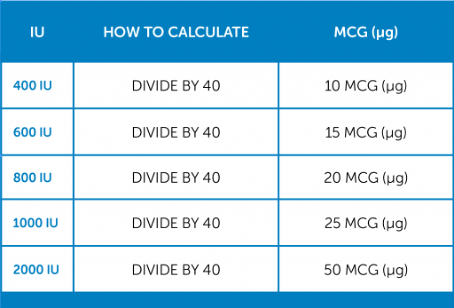January 20, 2020
When you look at the vitamin D label, you might notice that the amount of vitamin D is given as “IU” in North America and “g” or “mcg” in other regions, such as the United Kingdom.
What does “IU” mean?
“IU” stands for International Units, which measure the potency, or biological activity of a product. Whereas micrograms, with the short-form “g” or “mcg” units, depicts an amount based on mass or volume, something that we can literally see or feel. [1]
Why is “IU” used on vitamin D label?
Using “IU” has shown to be helpful to pharmacologists when products have more than one form, such as the case with vitamin D. Vitamin D has two different forms that are found in supplements: vitamin D2 (ergocalciferol), and vitamin D3 (cholecalciferol). Each of these has a different biological activity or potency, so scientists need a reliable way to compare the potency of these two vitamins.
Converting between International Units and Micrograms
A simple approach to converting measurements is the following vitamin D conversion table:

Reading vitamin labels
Using International Units and micrograms has been confusing for consumers. There is no universally adopted way to measure vitamin D, with each country choosing their own unit of measurements. In most European countries micrograms (µg) are considered the preferred unit of measurement. In the future, both ways of dosing are likely going to be shown on the packaging. [2]
It is important to always refer to the nutritional information and directions provided by the product (typically located on the side of the packaging), and to speak to your health care professional before taking any new medications.
This article was reviewed and updated in August 2019







Để lại một bình luận
Trang web này được bảo vệ bằng hCaptcha. Ngoài ra, cũng áp dụng Chính sách quyền riêng tư và Điều khoản dịch vụ của hCaptcha.